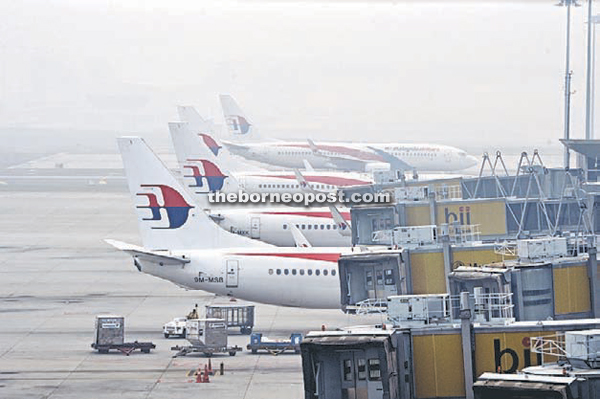
For the Malaysia Airports Holdings Bhd (MAHB), the depreciation of the ringgit is expected to be beneficial for the airport operator.
KUCHING: Analysts expect a gradual recovery in tourism and air travels, especially towards the second half of 2016 (2H16), as tourism campaigns and other efforts to ensure Malaysia’s reputation are raised to improve foreign tourists’ perceptions of the nation.
The research arm of Hong Leong Investment Bank Bhd (HLIB Research) said for 2016, it expects the aviation sector to benefit from an expected a gradual recovery in tourism and air travels, as continued aggressive campaigns on promoting Malaysia destinations and efforts on ensuring health, safety and security, should gradually improve foreign tourists perceptions.
“On the other hand, Malaysian travellers are gradually adjusting to the increasing living cost and ringgit depreciation in 2015, as indicated by the low consumer confident index.
“We expect the affected consumer sentiment to show improvement towards 2H16, tagging along improvement on air travel demand,” it added.
In 2016, the research team also believed that better structured capacity addition is expected to match the gradual recovery in air travel demand.
“Post capacity rationalisation exercise in 2015, Malaysia Airlines (MAS) will be more focused in expanding its domestic and regional networks, integrating with long-hauls (code-sharing), while AirAsia Bhd (AirAsia) is also working towards equitable supply-demand growth.
“Given the on-going capacity rationalization by MAS and cautious capacity additional by AirAsia, which will limit the overall capacity available in the system in 2016 while air travel demand is expected to gradually improve towards 2H16, we expect overall yield to improve further in 2016.
“Back in 2015, we have already started to witness overall yield improvements by AirAsia and AirAsia X Bhd (AirAsia X) mainly due to MAS capacity rationalisation exercise, effectively diminishing capacity oversupply in the system (which will address investors’ concerns on yield depression).
“Note that overcapacity arose back in 2013 mainly due to aggressive overexpansion by airlines and sudden drop in the demand for air travel post air travel incidents in 2014 and followed by negative consumer sentiments in 2015,” the research team explained.
Aside from that, HLIB Research pointed out that the aviation industry stands to benefit from low jet fuel price, which has slumped further in 2015 to US$45 per barrel (bbl) and is expected to stay low in 2016.
“Within our universe, AirAsia is the only airline counter we have official coverage. AirAsia has hedged 41 per cent of its fuel requirement for 2016 at US$63 per bbl.
“With jet fuel prices trending at current level of US$45 per bbl, average AirAsia’s jet fuel cost for 2016 could fall to US$50 to US$55 per bbl level, lower than our assumed US$65 per bbl.
“Hence, we expect AirAsia to experience margin expansion in 2016 from sustainable yield and lower cost structure attributed to lower jet fuel cost,” the research team said.
As for the ringgit movement and its impact on the aviation sector, HLIB Research the net impact of ringgit depreciation is company specific.
For the Malaysia Airports Holdings Bhd (MAHB), the depreciation of the ringgit is expected to be beneficial for the airport operator.
MAHB has exposure towards the euro income through its wholly owned subsidiary Istanbul Sabiha Gocken International Airport (ISGA) which operates mainly in euro currency.
“Given the expected positive contribution from ISGA to MAHB in 2016, ringgit weakness will translate into higher ringgit earnings to MAHB,” it added.
As for AirAsia, HLIB Research said the group was exposed to US dollar mainly through its maintenance expenses, operating leases and US dollar denominated debts (including interest expenses).
“Hence, US dollar appreciation (ringgit depreciation) will lead to higher ringgit denominated expenses and lower AirAsia’s margin.
“Nevertheless, AirAsia has partially hedged (circa 55 per cent) its principal loans for its Malaysia deployed aircrafts at RM3.25 per US dollar.
“Despite the negative impact from ringgit depreciation, AirAsia is still enjoying net positive impact from improving yields and slump in jet fuel prices.”
Overall, HLIB Research maintained an ‘overweight’ recommendation on the sector on the expectation of recovering air travel demand, improving yields and lower jet fuel prices.
